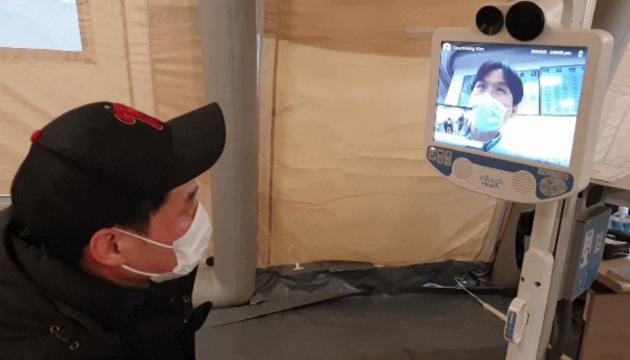On Sunday at 5:30 p.m., a patient with fever visited Myongji Hospital in Goyang, Gyeonggi Province, where the third confirmed patient with the novel coronavirus is being quarantined. The hospital immediately guided the patient to an isolated examination room, asked the patient to fill out a form to check for China travel records, and see an emergency medicine specialist for a preliminary check-up. As the patient turned out to have visited China recently, the hospital suspected a new case of the novel coronavirus infection and called a pulmonologist. However, the patient did not directly meet the pulmonologist. Seated in front of a camera, the patient saw the doctor for a secondary check-up through a monitor attached to a machine. The pulmonologist examined the patient through RP-Lite V2, a robot installed in the isolated examination room. The doctor confirmed that the patient showed symptoms of the new coronavirus infection, and the hospital admitted the patient to the negative pressure room for further treatment.

Myongji Hospital has come up with a scenario described above in case a patient with a suspected new coronavirus infection visits its separated examination room. The description shows how the hospital connects physicians in the pulmonary and infectious disease department with the patient through a robot and how to quarantine the patient in the negative pressure room in case the patient shows apparent symptoms of the new coronavirus infection.
To prevent healthcare workers from contracting a novel coronavirus, Myongji Hospital introduced telemedicine in the isolated examination room using a robot for the first time in Korea.
Myongji Hospital is treating the third confirmed patient at the negative pressure ward, designated by the government. The hospital divided the examination process in the isolated examination room into two and started to use the RP-Live V2 robot, developed by a U.S. firm InTouch Health, in the primary screening.

RP-Lite V2 is equipped with a high-definition camera and monitor. With a zoom-in/zoom-out function and a connection to a smartphone in Wi-Fi signals, the robot makes it possible for a physician and a patient to check each other’s faces.
Myongji checks fever for all visitors and sends those with a fever over 37.5 degrees to the separated examination room. If a patient needs to see a specialist in other departments during the primary check-up by an emergency medicine doctor, the hospital connects the robot with the necessary physician providing telemedicine.
Multiple people can connect to the RP-Live V2 robot simultaneously, which allows specialists in various fields to examine the patient together. The machine has a USB connector to display related data on the screen.
The robot also has a freely moveable camera so that a doctor can see a specific part of a patient’s body.
“Providing telemedicine through a robot at the isolated examination room means that the hospital is separating doctors at the room from other physicians.” Myongji Hospital Chairman Lee Wang-jun said. “This is because other doctors should not contact patients who visit the isolated examination room. Physicians other than the isolated examination room team should not enter the room.”
Lee added that the telemedicine system at the separated screening room was to promote the safety of both medical staff and patients. He also noted that Myongji Hospital is also planning to use the robot in the negative pressure room.
RP-Lite V2 is a medical robot developed by InTouch Health. Equipped with a stethoscope and a vital measurement system, the robot is used for medical examination in real situations.
As Korea bans telemedicine, however, the machine comes without a stethoscope and a vital measurement system. It is used for operational testing and research purposes for effectiveness within the legal boundary.
In 2018, Myongji Hospital signed a memorandum of agreement with InTouch Health to jointly carry out a pilot project to build a Korean version of a telehealth system model.
The hospital adopted two units of RP-Lite V2 to establish a telemedicine system among Myongji Hospital, Incheon Sarang Hospital, and Incheon Sarang Nursing Home.

